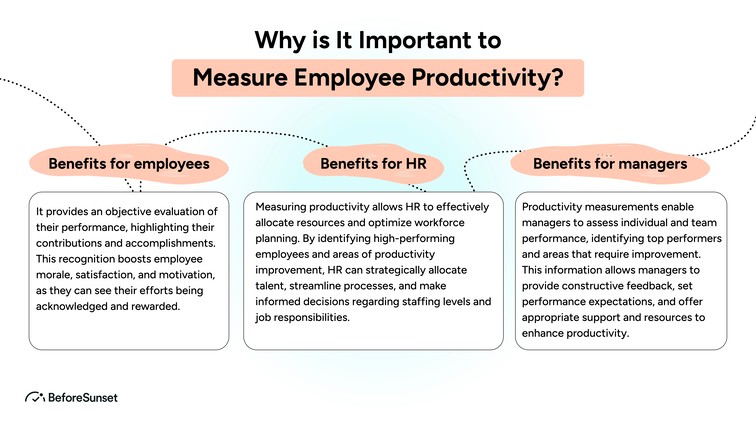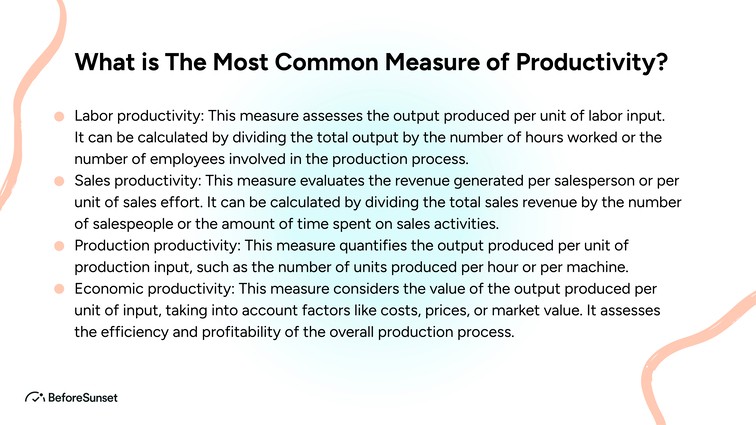A typical office worker is only productive 60% of the time or less every day, according to study. In reality, a Voucher Cloud survey revealed that most workers are only ineffective 60% of the time. They only work for two hours and twenty-three minutes each day.
Organizations looking to maximize performance, promote efficiency, and accomplish their goals must measure employee productivity. Effective productivity assessment identifies improvement opportunities, offers insightful information about team and individual performance, and facilitates data-driven decision-making.
However, choosing the appropriate methods to gauge productivity necessitates careful evaluation of elements including the sector, job functions, and organizational goals. We'll look at some of the top techniques and strategies for gauging staff productivity in this article. We will look at a variety of methods that may be customized to match the particular requirements and features of various businesses, ranging from objective quantitative measurements to qualitative assessments.
Organizations may promote a culture of continuous development, raise employee engagement, and promote success by knowing how to assess productivity efficiently.

What is Productivity?
When we talk about productivity, we're talking about the ratio of output to input in a certain activity, process, or system. It measures the efficiency with which resources, including time, labor, capital, or materials, are used to achieve desired goals. Productivity is a key idea in many areas, including industry, business, economics, and personal growth.
Macroeconomic productivity, such as that of a nation's economy or a particular industry, is frequently measured at the level of economics. It is computed by dividing the entire output by the total input, which might include labor hours, capital investment, or other relevant elements. In general, increased productivity results in economic development, higher living standards, and more competitiveness.
Productivity in a business setting refers to how effectively a firm runs its operations and its capacity to produce outputs (goods or services) with the resources at hand. It may be quantified using a variety of criteria, including sales per square foot, production per hour, and revenue per employee. In business, increased productivity frequently results in increased profitability, cost savings, and a competitive edge in the marketplace.
A person's capacity to efficiently manage their time and resources to attain desired objectives and outcomes is referred to as productivity on a personal level. It entails increasing productivity while reducing wastage of resources like time or effort. Techniques like prioritizing, goal-setting, time management, delegating, and continual learning can improve one's own productivity.
Why is It Important to Measure Employee Productivity?
A number of factors make staff productivity measurement crucial:
Performance Assessment: Employers can evaluate the performance of specific individuals or teams by measuring productivity. It offers a quantitative framework for assessing how well individuals use their time, abilities, and resources to complete projects and reach objectives. Performance evaluations, career advancements, and reward initiatives can all benefit from this data.
Resource Allocation: Organizations can pinpoint places where resources are being underused or where bottlenecks could exist by analyzing productivity. Making educated judgments on resource allocation, workforce planning, and finding areas for process improvement or automation is made easier with the use of this information.
Goal Setting and Target Achievement: Setting and achieving realistic objectives and targets for staff members and teams is made possible by measuring productivity. Organizations are able to monitor their progress, pinpoint areas for growth, and coordinate their efforts to meet predetermined goals thanks to this. It also aids in identifying high-performing people or groups as well as areas that could need further assistance or instruction.
Performance Enhancement: Productivity measurement identifies areas with poor productivity or process inefficiencies. Organizations may put measures in place to promote general efficiency, simplify operations, improve performance, and decrease waste by identifying these areas. It helps firms foster a culture of continuous development and keeps them competitive in a market that is undergoing fast change.
Cost-effectiveness: Measuring employee productivity aids businesses in finding places where they may save costs. Organizations may optimize workforce levels, spot areas of wasteful spending, and put plans in place to lower operational costs without sacrificing production or quality by knowing how resources are used.
Employee Engagement and Motivation: Boosting employee engagement and motivation may be done by measuring productivity and giving feedback. Employees may better comprehend expectations, monitor their progress, and feel a sense of success with the support of clear performance indicators and frequent feedback. Additionally, it offers chances for professional advancement, incentive, and recognition, all of which can improve morale and job satisfaction.
Decision Making: Making decisions: statistics-driven decision making is made possible by accurate productivity statistics. This data may be used by organizations to make well-informed decisions on process modifications, resource allocation, educational requirements, and performance management tactics. It assists managers in finding trends, patterns, and opportunities for development that can enhance the success of the entire firm.

1. Benefits for employees
Employee productivity measurement has a number of advantages. First of all, it makes performance objectives and goals clear, enabling workers to concentrate their efforts and properly prioritize tasks.
Additionally, productivity monitoring makes it possible to recognize top performers, which boosts motivation, morale, and work satisfaction. It also makes it easier for employees to grow their skills by pointing out potential improvement areas, which leads to more focused training and development opportunities.
Also, productivity assessment promotes a culture of continual development by giving staff chances to share ideas, simplify procedures, and increase overall effectiveness. Employees can ultimately feel a sense of success, improve, and have more prospects for recognition and progress when productivity is assessed and rewarded. You can also boost your career by watching documentaries.
2. Benefits for HR
Organizational HR (Human Resources) departments gain a number of advantages from tracking staff productivity. First off, it offers useful information for decision-making and performance evaluation.
Utilizing productivity data, HR can evaluate team and individual performance, pinpoint areas for development, and make knowledgeable decisions about resource allocation, training, and promotion. HR can identify workforce concerns or bottlenecks that may need action by tracking trends and patterns over time through productivity assessment.
Furthermore, productivity data may assist HR in creating efficient performance management plans, establishing sensible targets, and coordinating personal and corporate goals. HR can improve the effectiveness, engagement, and success of the workforce in general by utilizing productivity assessment and making data-driven decisions that improve organizational performance and productivity.
3. Benefits for managers
The benefits of measuring staff productivity for managers within a business are numerous. First off, it provides unbiased, quantitative data that managers can use to evaluate the performance of their teams and specific personnel.
Managers may recognize and reward high-performing people and teams with the help of productivity measures. Additionally, managers may use productivity assessment to pinpoint inefficiencies or bottlenecks, giving them the tools they need to optimize resource allocation and execute process improvements.
Managers may allocate jobs efficiently, establish attainable targets, and guarantee that workloads are balanced by knowing the productivity levels of their team members. Managers may track progress, make educated choices, and give helpful criticism to improve employee performance with the use of this data-driven method.

What is Challenging About Measuring Productivity?
Measuring productivity can present several challenges, including:
Defining and Measuring Output: Determining what constitutes the appropriate output or outcome can be challenging, especially in knowledge-based or creative roles where results may not be easily quantifiable. Finding suitable metrics that accurately reflect the value and quality of output can be complex and may require careful consideration.
Accounting for Diverse Job Roles: Different job roles and functions have unique requirements and responsibilities, making it difficult to compare productivity across different positions. The productivity measurement approach needs to be tailored to each role and consider the specific tasks, objectives, and challenges associated with that particular job.
Subjectivity and Bias: Productivity measurement can be subjective and prone to bias, as it often involves qualitative assessments and judgments. Managers may have different interpretations of productivity, leading to inconsistencies in evaluations. Biases can arise from factors such as personal relationships, perceptions, or implicit biases, which may impact the accuracy and fairness of productivity measurements.
Balancing Quantity and Quality: Productivity measurements often focus on output quantity, such as the number of units produced or tasks completed. However, this emphasis on quantity may overlook the quality of work, leading to a potential trade-off between quantity and quality. Balancing these factors appropriately is crucial to ensure a comprehensive assessment of productivity.
Capturing Non-Measurable Factors: Productivity measurement typically focuses on tangible outcomes, but it may overlook intangible factors that contribute to overall performance. Factors like creativity, innovation, problem-solving, collaboration, and employee well-being can significantly impact productivity but may not be easily quantifiable. Failure to capture these non-measurable factors can result in an incomplete assessment of productivity.
External Factors and Context: Productivity can be influenced by various external factors beyond the control of employees or teams. Factors such as market conditions, technological limitations, resource constraints, or interruptions can affect productivity levels. It is challenging to isolate and account for these external factors when measuring productivity accurately.
Resistance and Gaming: Employees may resist productivity measurement if they perceive it as intrusive, unfair, or a means of excessive surveillance. In some cases, employees may try to game the system by focusing solely on metrics rather than the overall value of their work. This can lead to unintended consequences and distortions in productivity measurement.
To overcome these challenges, organizations should adopt a comprehensive approach that combines quantitative and qualitative measures, involves input from employees, considers the unique aspects of different roles, and incorporates a balanced assessment of both output quantity and quality. Regular feedback, open communication, and a focus on a culture of continuous improvement can help address some of the challenges associated with measuring productivity.

What is The Most Common Measure of Productivity?
A crucial component of assessing effectiveness and performance in a variety of businesses and organizations is productivity measurement. While there are many ways to gauge productivity, certain methods are more often employed than others.
These frequently used productivity indicators offer a quantitative framework for evaluating the output produced in relation to the used inputs. Organizations may obtain important insights into their operational effectiveness, resource usage, and overall performance by studying the most popular productivity measurements.
We will examine several of the most popular productivity indicators in this talk, emphasizing their uses and importance in various circumstances. Organizations may assess their productivity, find areas for development, and make well-informed decisions to increase performance by understanding these metrics.
Labor Productivity
The output produced per unit of input work is calculated using the widely used metric of labor productivity. It offers perceptions into a workforce's efficacy and efficiency in turning labor hours into observable results. The ratio of overall output, such as sales income, units produced, or services provided, to the number of hours worked or the number of personnel participating in the production process is how labor productivity is frequently expressed.
This measurement is especially important in fields where labor is a major factor in the creation or provision of goods or services. The use of worker productivity as a key performance measure is popular in the manufacturing, construction, and service industries. Organizations may evaluate how well their staff uses their time and talents to produce output by looking at labor productivity.
Numerous advantages, including higher output, cost effectiveness, and improved competitiveness, can result from improving worker productivity. It lets firms to allocate resources efficiently, spot inefficient areas, and put measures in place to increase worker performance or simplify procedures.
However, it's crucial to take into account the constraints of labor productivity as a measurement. It might not accurately reflect the worth and complexity of some positions, particularly those in knowledge-based or creative industries. This metric could not accurately reflect elements that affect total productivity, such as cooperation, collaboration, creativity, and employee well-being.
Nevertheless, labor productivity continues to be a useful tool for businesses to evaluate and analyze the performance of their workers, spur operational advancements, and make wise choices about staffing numbers, training, and resource allocation. Organizations may work toward increased productivity and efficiency, accomplish their objectives, and stay competitive in the fast-paced business environment of today by concentrating on worker productivity.
Output per Hour
A typical productivity metric is output per hour, which measures the quantity of output or work completed in a particular laboring hour. It measures how effectively and efficiently workers produced output during a certain time period.
This measurement is especially important for fields like manufacturing, data entry, call centers, and other repetitive operations where it is simple to quantify and assess tasks or work units. The ratio of overall output (such as units produced, services provided, and activities done) to the number of hours worked is how output per hour is frequently stated.
Organizations can assess the productivity of their employees in terms of the amount of work performed within a specific time frame by measuring output per hour. It enables comparisons between people or teams and offers a foundation for identifying top performers or areas that need work. This metric also aids in evaluating the effects of attempts to increase productivity such as process modifications, technology adoption, or other.
Increasing production per hour can result in more efficient processes, more productivity, and lower costs. Organizations may use it to better allocate resources, spot and fix bottlenecks, and increase overall operational effectiveness. Organizations may boost productivity by establishing benchmarks and objectives based on production per hour and tracking advancement over time.
Along with production per hour, it's crucial to take quality into account. Lack of attention to the value of producing high-quality work or accomplishing desired results may result from a singular concentration on quantity. To guarantee a thorough evaluation of production, it is essential to strike a balance between quantity and quality.
Revenue per Employee
A frequently used productivity indicator, revenue per employee evaluates the amount of money produced per employee over a specific time period. It offers perceptions into the efficacy and efficiency of a workforce in driving income or sales for a business.
In service-oriented businesses like consulting, banking, software development, or other knowledge-based industries, this indicator is very important. The entire money earned is divided by the organization's employee count to determine revenue per employee.
Organizations may assess the productivity and income-generating potential of their staff by measuring revenue per employee. It enables comparisons across various teams, departments, or people and serves as a foundation for finding areas of high performance or future growth. This metric also aids in evaluating the effects of process modifications, marketing plans, or other productivity-boosting measures.
Increased profitability, cost effectiveness, and overall organizational performance can result from raising revenue per employee. It promotes businesses to maximize employee productivity, improve sales tactics, and make sure that resources are allocated efficiently. Organizations may find growth possibilities, pinpoint areas for skill improvement or training, and make wise decisions to increase productivity and income by defining goals and tracking revenue per employee.
While revenue per employee is a useful indicator, it's necessary to take into account other elements that affect organizational success, like market circumstances, employee engagement, and customer happiness. The industry, company strategy, and market dynamics should all be taken into account when interpreting a high revenue per employee ratio.
Sales per Square Foot
In the retail sector, sales per square foot is a regularly used metric to assess the volume of sales produced per square foot of shop space. By measuring the income earned in relation to the actual selling space, it offers insights into the effectiveness and profitability of a retail business.
For brick-and-mortar retailers, where the efficient use of retail space is essential for boosting sales, this metric is particularly pertinent. By dividing the whole sales income by the total square footage of the store's selling space, sales per square foot are computed.
Retailers may assess the efficiency and efficacy of their physical shop locations by monitoring sales per square foot. Making educated judgments about store layouts, merchandising tactics, and product assortment is made possible by the ability to compare various stores, identify high-performing or underperforming locations, and identify high-performing or underperforming locations.
Gaining more sales per square foot may boost profits, optimize shop designs, and improve customer experiences. It urges merchants to evaluate and enhance their retail locations, make effective use of available floor space, and pinpoint places where product placement or shop design needs to be improved. Retailers may increase income, enhance shop performance, and allocate resources efficiently by establishing standards and tracking sales per square foot.
It's crucial to keep in mind, too, that sales per square foot may range between various retail categories and shop styles. The sales potential per square foot can be influenced by elements including store location, target market, product price, and industry standards. To provide insightful comparisons, similar shop types or within the same retail market should be used.
Value-Added Productivity
Value-added productivity is a metric that assesses the value that has been contributed to a good or service at each stage of the manufacturing process. It focuses on evaluating the efficacy and efficiency of transforming inputs into outputs with increased value.
This metric is especially important in areas like manufacturing, assembly, or production-oriented businesses where the conversion of inputs into value outputs is a critical component of the business. The value of inputs (such as raw materials, components, or labor) and the value of the finished product are taken into consideration in the concept of value-added productivity.
By monitoring value-added productivity, businesses may evaluate the efficiency of their production processes, spot inefficiencies or waste, and put measures in place to better use resources. It aids in the comprehension of the value creation process and points out areas where cost savings, quality enhancement, or innovation may be possible.
Increasing value-added productivity can have a number of advantages, such as higher profitability, cost effectiveness, and competitiveness. It enables businesses to optimize production procedures, spot non-value-added tasks and stop them, and concentrate resources on jobs that directly contribute to value creation. Organizations may optimize their operations, improve customer happiness, and promote economic success by systematically tracking and enhancing value-added production.
It's vital to remember that value-added productivity takes into account both the value contributed throughout the production process as well as output quantity. It considers elements like product quality, innovation, and client happiness. This metric encourages businesses to think more broadly about value creation and not just use output volume as a metric for productivity.

Best Methods for Productivity Measurements
Output-based measurement: Measurement that is based on output puts the emphasis on measuring the output or results attained by individuals, teams, or departments. It entails tracking measurable outcomes like units produced, sales money, customer satisfaction scores, or activities done. The manufacturing, sales, and service-oriented businesses benefit most from this approach.
Measurement based on inputs: Using this approach, productivity is evaluated by looking at the inputs needed to produce a specific outcome. It entails assessing elements like work hours, resources used, or expenses paid to produce a certain result. Resource efficiency and cost effectiveness can be better understood through input-based measurement.
Total factor productivity (TFP): Total factor productivity (TFP) is a broad metric that assesses how effectively various inputs are converted into output. It considers a number of things, such as labor, capital, technology, and other resources. TFP analysis facilitates comparisons between various industries or time periods and assists in identifying general productivity improvements or losses.
Process-based measurement: This technique concentrates on examining and enhancing certain organizational processes. It entails determining the crucial stages, duration, and resource usage at each phase of the process. The goal of process-based measurement is to improve overall process efficiency by streamlining processes and removing bottlenecks.
Balanced Scorecard: The Balanced Scorecard methodology goes beyond standard productivity metrics to take into account a variety of performance indicators. To give a more thorough evaluation of organizational performance, it integrates viewpoints from the financial, customer, internal process, and learning and growth areas.
Value-added measurement: Measurement of value added measures the value that has been added to a good or service at each stage of the manufacturing process. In addition to taking into account elements like quality, innovation, and customer happiness, it calculates the difference between the value of the inputs and the value of the finished product.
Employee self-assessment and feedback: Participating in employee self-assessment and soliciting comments can yield insightful qualitative information on productivity in addition to quantitative metrics. Employee participation in the measuring process may aid in identifying productivity obstacles, boost morale, and promote a culture of continuous development.
What are the Differences in Measuring Productivity Based on the Industry?
Because each industry has own traits, working methods, and output measurements, measuring productivity can differ dramatically between sectors. In the manufacturing industry, production per work hour or unit, defect rates, cycle times, and equipment utilization are frequently used to measure productivity.
Although it might be difficult to measure productivity in the services sector, indicators like revenue per employee, customer satisfaction scores, or service delivery effectiveness may be used. Sales per square foot, average transaction value, and inventory turnover are frequently measured in the retail sector.
Patient outcomes, wait times, and operations carried out are the main concerns in healthcare. Construction assesses whether projects are finished on time and within budget, as well as the efficiency of its equipment. Professional services take project profitability, billable hours, and revenue per customer into account. Input usage, crop quality, and yield per acre are tracked in agriculture.
These sector-specific methodologies make sure that productivity metrics are in line with the unique outputs, limits, and goals of each industry, allowing for insightful analysis and focused improvements.
What’s Employee Productivity for You?
Employee output or work completed within a specific time frame is referred to as employee productivity. It evaluates how successfully a person or a group completes tasks, achieves objectives, or adds to the overall performance of an organization.
A number of indicators, including output volume, work quality, meeting deadlines, resource usage, and flexibility, may be used to measure an employee's productivity. Skills, motivation, the workplace climate, support networks, and the alignment of corporate and personal objectives are influencing variables.
In the end, staff productivity is a major factor in determining the performance, success, and profitability of a firm.
How Can You Measure Your Employee Productivity With BeforeSunset?
Utilizing the features and capabilities of the program in order to acquire insights into employee performance is part of measuring employee productivity with BeforeSunset. You may assess several facets of productivity by using time monitoring tools, task management capabilities, and reporting functions.
You can monitor how much time employees spend on various jobs and projects, spot regions of high or poor productivity, and examine trends and patterns thanks to the program. You may also keep an eye on workflow efficiency, project milestones, and job completion rates.
You can make data-driven choices, efficiently manage resources, and provide targeted feedback and coaching to enhance performance using the software's reports and analytics, which provide you a full perspective of employee productivity.

